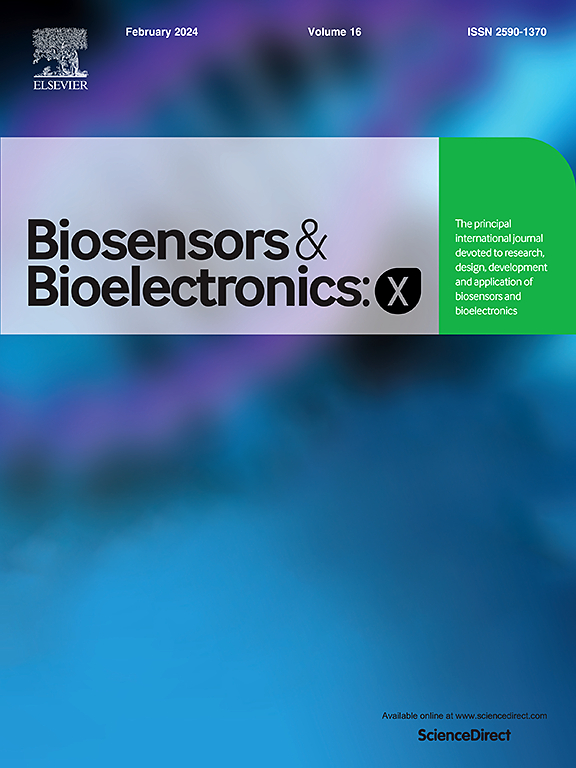基于酪氨酸酶的生物传感器的新方法:电极反应和生物测量
IF 10.61
Q3 Biochemistry, Genetics and Molecular Biology
引用次数: 0
摘要
本研究介绍了一种基于酪氨酸酶的新型生物传感器,旨在同时检测酪氨酸酶、酪氨酸、L-DOPA 和 L-DOPA 醌。该生物传感器被命名为 GCE/GNP/Cys/Chit/Tyrase,是通过将酪氨酸酶固定在改良的玻璃碳电极(GCE)上而开发出来的,该电极结合了电沉积金纳米粒子、半胱氨酸和壳聚糖。使用扫描电子显微镜(SEM)对生物传感器的形态进行了表征。针对目标分析物,对生物传感器的电化学行为进行了探索。对主要分析特性进行了评估,包括线性范围、灵敏度、选择性、检出限和定量限、长期稳定性、重复性、再现性、电化学活性表面积和电荷转移行为。该生物传感器的线性响应范围为 1-120 μM,灵敏度高达 200.4 mA.Lmol-1cm-2,检测限为 27 μM。这项研究全面评估了基于酪氨酸酶的生物传感器的分析特性。此外,该生物传感器还被用于定量检测脑组织中的多巴胺,使用的校准曲线是由制造的生物传感器得出的。在五只 Wistar 大鼠体内测得的多巴胺浓度为 35 ± 2.75 μM,分别反映了平均值和标准偏差。这些结果证实了该生物传感器能够准确检测 Wistar 大鼠大脑中的这种关键神经递质。这项研究凸显了基于酪氨酸酶的生物传感器在生物样本的多种分析应用中的潜力。本文章由计算机程序翻译,如有差异,请以英文原文为准。
A novel approach to tyrosinase-based biosensors: Electrode reactions and biological measurement
This study introduces a novel tyrosinase-based biosensor designed to simultaneously detect tyrosinase, tyrosine, L-DOPA, and L-DOPA quinone. The biosensor, designated as GCE/GNP/Cys/Chit/Tyrase, was developed by immobilizing tyrosinase on a modified glassy carbon electrode (GCE) that incorporates electrodeposited gold nanoparticles, cysteine, and chitosan. The morphology of the biosensor was characterized using scanning electron microscopy (SEM). The electrochemical behaviors of the biosensor were explored in response to the target analytes. Key analytical characteristics were assessed, including linear range, sensitivity, selectivity, limits of detection and quantification, long-term stability, repeatability, reproducibility, electrochemically active surface area, and charge transfer behavior. The biosensor demonstrated a linear response range of 1–120 μM, with an impressive sensitivity of 200.4 mA.Lmol−1cm−2 and a detection limit of 27 μM. This study provides a comprehensive evaluation of the analytical features of tyrosinase-based biosensors. Additionally, the biosensor was applied to quantify dopamine in brain tissue, utilizing a calibration curve derived from the fabricated biosensor. The dopamine concentration measured in five Wistar rats was 35 ± 2.75 μM, reflecting the mean and standard deviation, respectively. These results confirm the biosensor's capability for accurately detecting this critical neurotransmitter in the brains of Wistar rats. This investigation underscores the potential of tyrosinase-based biosensors for diverse analytical applications in biological samples.
求助全文
通过发布文献求助,成功后即可免费获取论文全文。
去求助
来源期刊

Biosensors and Bioelectronics: X
Biochemistry, Genetics and Molecular Biology-Biophysics
CiteScore
4.60
自引率
0.00%
发文量
166
审稿时长
54 days
期刊介绍:
Biosensors and Bioelectronics: X, an open-access companion journal of Biosensors and Bioelectronics, boasts a 2020 Impact Factor of 10.61 (Journal Citation Reports, Clarivate Analytics 2021). Offering authors the opportunity to share their innovative work freely and globally, Biosensors and Bioelectronics: X aims to be a timely and permanent source of information. The journal publishes original research papers, review articles, communications, editorial highlights, perspectives, opinions, and commentaries at the intersection of technological advancements and high-impact applications. Manuscripts submitted to Biosensors and Bioelectronics: X are assessed based on originality and innovation in technology development or applications, aligning with the journal's goal to cater to a broad audience interested in this dynamic field.
 求助内容:
求助内容: 应助结果提醒方式:
应助结果提醒方式:


